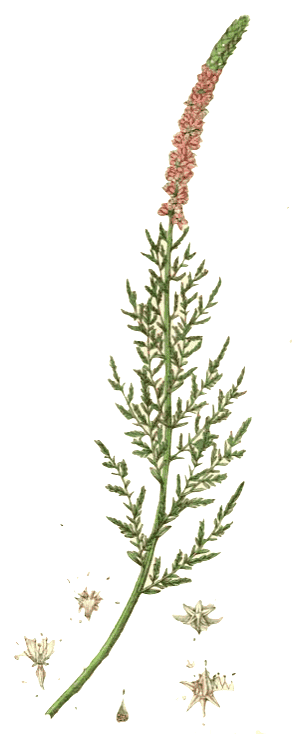Myricaria, ‘Om bu འོམ་བུ
False Tamarisk‘Om bu (Tibetan)
 Myricaria bracteata
Myricaria bracteataJ.F. Royle, Illustrations of the botany and other branches of the natural
history of the Himalayan Mountains and of the flora of Cashmere, vol. 2 (1839)
Botanical name:
Myricaria spp.
Several species are used:
1. M. bracteata
2. M. squamosa
3. M. elegans (syn. M. hoffmeisteri)
4. M. longifolia (syn. M. linearifolia, Tamarix germanica, T. decandra, T. longifolia)
Other species have been listed including M. germanica, M. prostrata, M. dahurica
Parts used:
Shoot, aerial parts
Temperature & Taste:
Cold, dry. Bitter, Sour, Sweet
Uses:
1. Clears Heat, Resists Poison:
-Fever
-various types of Poisoning including Meat (Food) Poisoning
-Acne, Pimples, especially those that don’t ripen
-applied topically to Sores and Pimples
2. Clears Heat and Damp:
-Bile diseases
-dries serous humors
-accumulation of fluid in the Joints
3. Clears Heat, Stops Cough:
-Heat type Cough with yellow phlegm
Dose:
Comment:
The leaves are also used in religious rituals.
Main Combinations:
1. To clear Poison and detoxify the Liver, Myricaria, Inula racemosa, Tinospora, Rubus spp.
2. Damp affecting the Spleen, Myricaria with Amomum and Costus
Major Formulas:
Amomum 19 (Ko la 19) (Tibetan Medicine)
Great Decoction 25 (Thang Chen Nyer Inga) (Tibetan Medicine)
Rinchen Danjor (Precious Pill)
Cautions:
None noted
